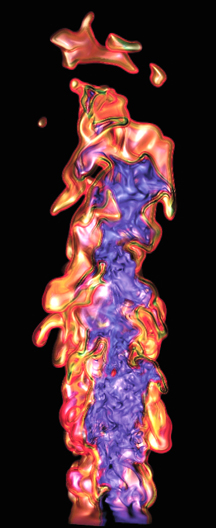Jackie Chen (8351) and a team of collaborators have been awarded more than six million hours of computing time on the Cray X1E and XT3 supercomputers at Oak Ridge National Laboratory to study flame phenomena. The award comes from DOE’s Office of Science and is part of the department’s 2007 Innovative and Novel Computational Impact on Theory and Experiment (INCITE) program, will allow cutting-edge research and design of virtual prototypes to be carried out in considerably less time than it would take using conventional computing systems.

Jackie’s team, Chun Sang Yoo (8351), David Lignell (8351), Ramanan Sankaran (Oak Ridge, 8351), Evatt Hawkes (8351), and Phil Smith (University of Utah), is working on an array of direct numerical simulations that will provide a fundamental understanding of key processes such as flame stabilization, flame structure, extinction, ignition, and soot formation. The high-quality simulated benchmark data will also be used by combustion modelers to develop predictive engineering models used to design future combustion devices. These processes underlie fuel-efficient low-temperature combustion engine designs for transportation and lean premixed combustion for stationary power generators. An increase in automobile fuel efficiency from 30 to 45 percent, experts say, would result in a savings of three million barrels of oil per day of the 20 million consumed for transportation with a corresponding decrease in CO2 emissions.
“Our project has strong applications and science impact, which given the importance of energy conservation and efficiency, very likely makes it all the more attractive to the Office of Science,” says Jackie, who works in Sandia’s Combustion Research Facility. Simulations developed by her and her team provide data to validate mixing and combustion models in engineering-level simulations of combustion devices. The award-winning project is titled “High-Fidelity Numerical Simulations of Turbulent Combustion — Fundamental Science Toward Predictive Models.”
The DOE Office of Science awarded 45 projects and a total of 95 million hours of computing time on some of the world’s most powerful supercomputers as part of the INCITE program. DOE Under Secretary for Science Raymond Orbach presented the awards at the Council on Competitiveness in Washington, D.C.
CPU hours valuable
Supercomputers are playing an increasingly important role in scientific research by allowing scientists to create more accurate models of complex processes, simulate problems once thought to be impossible, and to analyze the increasing amount of data generated by experiments. For example, a project receiving one million hours could run on 2,000 processors for 500 hours, or about 21 days. Running a one-million-hour project on a single-processor desktop computer would take more than 114 years.
“The Department of Energy’s Office of Science has one of the top 10 most powerful supercomputers in the world and four of the top 100 and we’re proud to provide these resources to help researchers advance scientific knowledge and understanding,” Energy Secretary Samuel Bodman said.
“I look forward to witnessing the promise of these efforts as some of the world’s greatest thinking minds use some of the world’s greatest thinking computers.”
Launched in 2003, the INCITE mission is to advance American science and industrial competitiveness. These awards will assist in that mission by supporting computationally intensive, large-scale research projects and awarding them large amounts of dedicated time on DOE supercomputers.
The projects, with applications from aeronautics to astrophysics, consumer products to combustion research, were competitively chosen based on the potential impact of the science and engineering research and the suitability of the project for use of supercomputers.
“One of the most important aspects of the INCITE program is that the resulting knowledge will largely be available, so that the information and technologies can be used by other researchers, further broadening the impact of this work,” Orbach said.
“Our scientific leadership underpins nearly every aspect of our economy and by making these resources available to a broad range of science and engineering disciplines; we believe the resulting work will make us more competitive in the years and decades to come.”
For 2007, the projects were awarded time at DOE’s Leadership Computing Facilities at Oak Ridge National Laboratory in Tennessee and Argonne National Laboratory in Illinois, the National Energy Research Scientific Computing Center at Lawrence Berkeley National Laboratory in California, and the Molecular Science Computing Facility at Pacific Northwest National Laboratory in Washington.